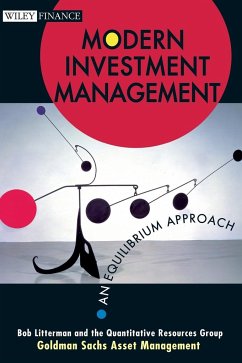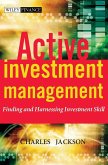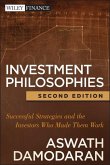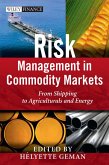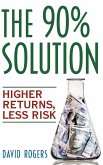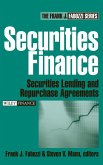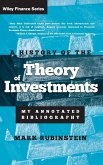Introduces the modern investment management techniques used by Goldman Sachs asset management to a broad range of institutional and sophisticated investors.
Along with Fischer Black, Bob Litterman created the Black-Litterman asset allocation model, one of the most widely respected and used asset allocation models deployed by institutional investors.
Litterman and his asset management group are often a driving force behind the asset allocation and investment decision-making of the world s largest 100 pension funds.
Along with Fischer Black, Bob Litterman created the Black-Litterman asset allocation model, one of the most widely respected and used asset allocation models deployed by institutional investors.
Litterman and his asset management group are often a driving force behind the asset allocation and investment decision-making of the world s largest 100 pension funds.
"...this is a state of the art exposition of modern investment techniques, full of brilliant analysis..." (Financial Times, September 29, 2003)
"...the book explains some investment management techniques used by GSAM..." (Pensions Management October 2003)
"...The strength of this book is its technical rigour..." (Investment and Pensions Europe, November 2003)"a state-of-the-art exposition of modern investment techniques, full of brilliant analysis..." (Financial Times, September 29, 2003)
"...the book explains some investment management techniques used by GSAM..." (Pensions Management October 2003)
"...The strength of this book is its technical rigour..." (Investment and Pensions Europe, November 2003)
"...the book explains some investment management techniques used by GSAM..." (Pensions Management October 2003)
"...The strength of this book is its technical rigour..." (Investment and Pensions Europe, November 2003)"a state-of-the-art exposition of modern investment techniques, full of brilliant analysis..." (Financial Times, September 29, 2003)
"...the book explains some investment management techniques used by GSAM..." (Pensions Management October 2003)
"...The strength of this book is its technical rigour..." (Investment and Pensions Europe, November 2003)
"... valuable resource for any market practitioners interested in or working in the asset management field... one of the better books." (Risk, April 2004)
With names ranging from Alford to Zangari, but led by Bob Litterman, an academy of 23 authors has produced the 600-page Goldman Sachs Asset Management textbook entitled Modern Investment Management: An Equilibrium Approach*. This is a state-of-the-art exposition of modern investment techniques, full of brilliant analysis but oddly detached from the real world.
A briefcase-busting volume may be an unusual marketing tool to distribute to clients, but GSAM's focus is conventional enough. After all, US pension plans have a daunting problem: their sponsors are typically projecting 9 per cent investment returns even though the risk-free US Treasury bond yield has recently been below 4 per cent (though it is now rising quite fast).
Even GSAM does not think the equity risk premium is more than 3.5 per cent (and many others say it is much less). So where can a 9 per cent expectation come from, other than the end of a rainbow?
One response would be to cut the targeted return to, say, 6 per cent, which could be achieved through a reasonably cautious mix of bonds and equities.
But such a capitulation would plunge many pension plans into serious deficit, and force sharp rises in contributions.
Companies like General Motors would not be able to borrow on the bond market and invest the proceeds in securities at a "profit".
Enter GSAM with an array of active risk opportunities, information ratio assumptions and derivatives strategies.
Uncorrelated hedge funds and private equity products add alpha, while interest rate and currency overlays can contribute extra return while hedging liability risks. This is the world of "active alpha" - the return generated by active deviations from the benchmark as distinct from beta, the market return.
The positive appeal lies is in GSAM's treatment of risk. In today's markets, fund managers can only outperform if they accept an appropriate amount of risk: not too much, not too little.
This applies across the spectrum from asset allocators to specialist portfolio managers.
Investors, however, tend to be apprehensive about the dependence of the sophisticated investment theories on historical data. In a crisis, these can malfunction badly. A "three standard deviation event" - which, mathematically, is supposed to be almost impossible - is, in fact, all too common.
Moreover, GSAM appears to inhabit an unreal world where the information ratio - the active return per unit of active risk - is 0.75 and a higher active risk therefore reliably generates higher returns.
This is fine if the investors consistently select brilliant fund managers.
But, in the real world, the average information ratio is zero (or negative, after costs) and portfolio risk is hard to measure with precision over any length of time.
There is a problem of lack of scalability too. "The best hedge funds are closed," admits GSAM. Managers of niche funds can select unusually profitable opportunities in inefficient markets (Japanese small cap equities being an oft-quoted example).
Moreover, alpha can then be "ported" into a mainstream asset class, using derivatives. But it is unlikely that big pension plans can thread their way nimbly through such investment minefields without triggering explosions.
What GSAM is in effect saying is that simple investment in mainstream equities and bonds is not going to generate the required returns. In particular, the soft option of index-tracking, which has been adopted by so many pension funds and other institutional investors, is a trap. The age of risk and skill is here.
There is little or nothing here about economic fundamentals, corporate governance or costs, the kind of subjects which dominate conventional investment committee meetings.
Fans of Warren Buffett definitely need not apply, although Bob Litterman observes that "there might be a little bit of extra reward for those armed with the most thorough, efficient and disciplined investment processes, even though competition will certainly quickly eliminate most such opportunities".
For Goldman Sachs, the attractions of active alpha are crystal clear. But although some investors may be ready to move along the quantative route, many pension fund trustees will wonder whether the game is becoming too hazardous and opaque. (Financial Times, September 29, 2003)
"...this is a state of the art exposition of modern investment techniques, full of brilliant analysis..." (Financial Times (FTfm))
"...the book explains some investment management techniques used by GSAM..." (Pensions Management, October 2003)
"...The strength of this book is its technical rigour..." (Investment and Pensions Europe, November 2003)
With names ranging from Alford to Zangari, but led by Bob Litterman, an academy of 23 authors has produced the 600-page Goldman Sachs Asset Management textbook entitled Modern Investment Management: An Equilibrium Approach*. This is a state-of-the-art exposition of modern investment techniques, full of brilliant analysis but oddly detached from the real world.
A briefcase-busting volume may be an unusual marketing tool to distribute to clients, but GSAM's focus is conventional enough. After all, US pension plans have a daunting problem: their sponsors are typically projecting 9 per cent investment returns even though the risk-free US Treasury bond yield has recently been below 4 per cent (though it is now rising quite fast).
Even GSAM does not think the equity risk premium is more than 3.5 per cent (and many others say it is much less). So where can a 9 per cent expectation come from, other than the end of a rainbow?
One response would be to cut the targeted return to, say, 6 per cent, which could be achieved through a reasonably cautious mix of bonds and equities.
But such a capitulation would plunge many pension plans into serious deficit, and force sharp rises in contributions.
Companies like General Motors would not be able to borrow on the bond market and invest the proceeds in securities at a "profit".
Enter GSAM with an array of active risk opportunities, information ratio assumptions and derivatives strategies.
Uncorrelated hedge funds and private equity products add alpha, while interest rate and currency overlays can contribute extra return while hedging liability risks. This is the world of "active alpha" - the return generated by active deviations from the benchmark as distinct from beta, the market return.
The positive appeal lies is in GSAM's treatment of risk. In today's markets, fund managers can only outperform if they accept an appropriate amount of risk: not too much, not too little.
This applies across the spectrum from asset allocators to specialist portfolio managers.
Investors, however, tend to be apprehensive about the dependence of the sophisticated investment theories on historical data. In a crisis, these can malfunction badly. A "three standard deviation event" - which, mathematically, is supposed to be almost impossible - is, in fact, all too common.
Moreover, GSAM appears to inhabit an unreal world where the information ratio - the active return per unit of active risk - is 0.75 and a higher active risk therefore reliably generates higher returns.
This is fine if the investors consistently select brilliant fund managers.
But, in the real world, the average information ratio is zero (or negative, after costs) and portfolio risk is hard to measure with precision over any length of time.
There is a problem of lack of scalability too. "The best hedge funds are closed," admits GSAM. Managers of niche funds can select unusually profitable opportunities in inefficient markets (Japanese small cap equities being an oft-quoted example).
Moreover, alpha can then be "ported" into a mainstream asset class, using derivatives. But it is unlikely that big pension plans can thread their way nimbly through such investment minefields without triggering explosions.
What GSAM is in effect saying is that simple investment in mainstream equities and bonds is not going to generate the required returns. In particular, the soft option of index-tracking, which has been adopted by so many pension funds and other institutional investors, is a trap. The age of risk and skill is here.
There is little or nothing here about economic fundamentals, corporate governance or costs, the kind of subjects which dominate conventional investment committee meetings.
Fans of Warren Buffett definitely need not apply, although Bob Litterman observes that "there might be a little bit of extra reward for those armed with the most thorough, efficient and disciplined investment processes, even though competition will certainly quickly eliminate most such opportunities".
For Goldman Sachs, the attractions of active alpha are crystal clear. But although some investors may be ready to move along the quantative route, many pension fund trustees will wonder whether the game is becoming too hazardous and opaque. (Financial Times, September 29, 2003)
"...this is a state of the art exposition of modern investment techniques, full of brilliant analysis..." (Financial Times (FTfm))
"...the book explains some investment management techniques used by GSAM..." (Pensions Management, October 2003)
"...The strength of this book is its technical rigour..." (Investment and Pensions Europe, November 2003)

